
YOUR GUIDE TO SAME-SEX MARRIAGE IN THE US AND AROUND THE WORLD
- At Your Leisure
- LGBTQ Pride
-
Aug 25
- Share post
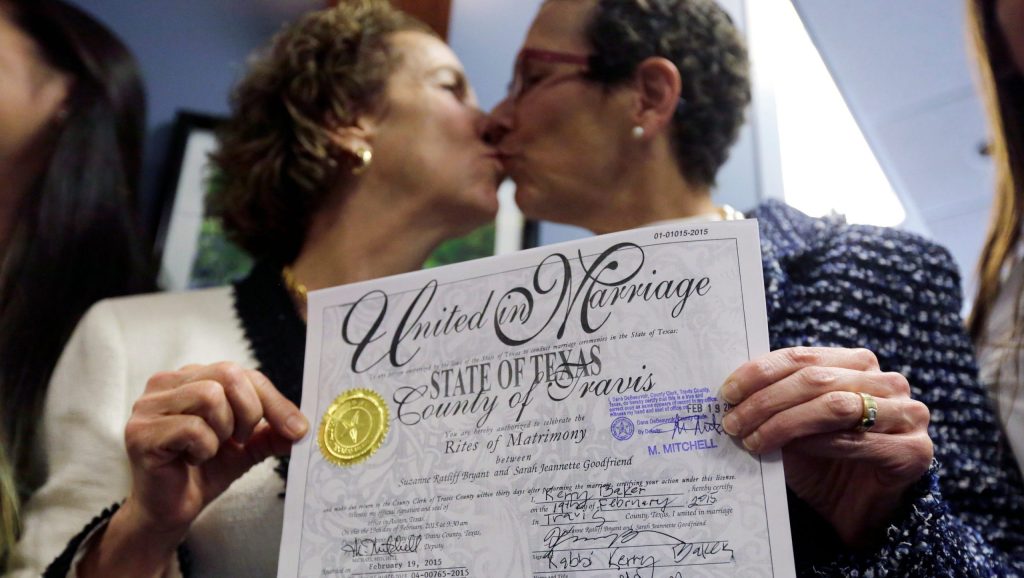
Today more and more governments around the world are considering giving legal recognition to same-sex marriages. So far, 30 countries and territories have enacted national laws allowing gays and lesbians to marry, mostly in Europe and the Americas. In this article, we will look into how it started and what led to where we are today.
HISTORY OF SAME-SEX MARRIAGE
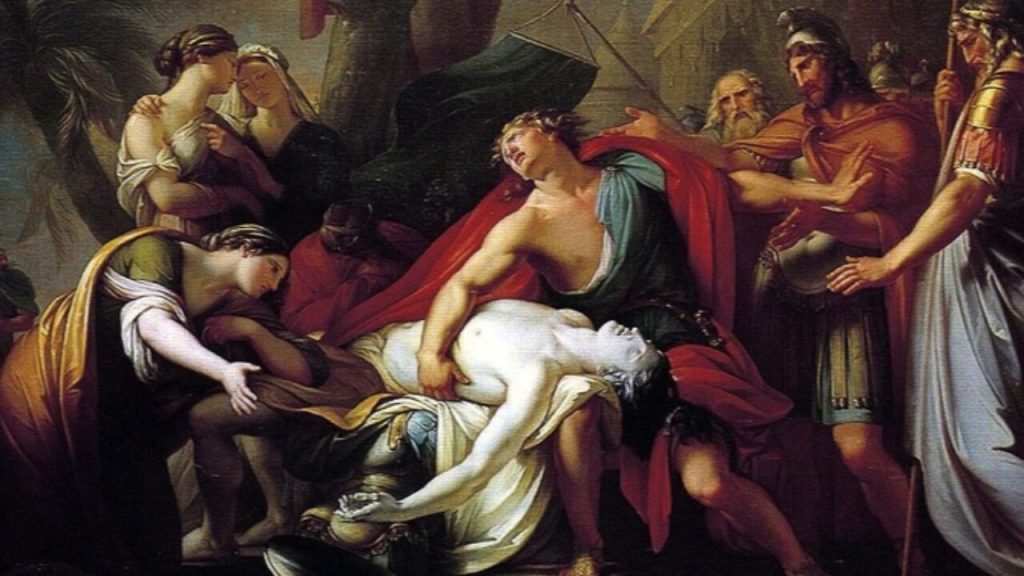
Same-sex unions were known in Ancient Greece and Rome, ancient Mesopotamia, in some regions of China, such as Fujian province, and at certain times in ancient European history.
Same-sex marital practices and rituals were more recognized in Mesopotamia than in ancient Egypt. The Almanac of Incantations contained prayers favoring on an equal basis the love of a man for a woman and of a man for a man.
In the southern Chinese province of Guangdong, during the Ming dynasty period, females would bind themselves in contracts with younger females in elaborate ceremonies. Males also entered similar arrangements. This type of arrangement was also similar in ancient European history.
An example of egalitarian male domestic partnership from the early Zhou dynasty period of China is recorded in the story of Pan Zhang & Wang Zhongxian. While the relationship was approved by the wider community and was compared to heterosexual marriage, it did not involve a religious ceremony binding the couple.
Some early Western societies integrated same-sex relationships. The practice of same-sex love in ancient Greece often took the form of pederasty, which was limited in duration and, in many cases, co-existed with marriage. Documented cases in this region claimed these unions were temporary pederastic relationships.
The Sacred Band of Thebes was so called because the male couples that formed it exchanged sacred vows between lover and beloved at the shrine of Iolaus, beloved of Heracles. These unions created a moral dilemma for the Greeks and were not universally accepted.
SAME-SEX MARRIAGE IN LITERATURE
Although Homer did not explicitly depict Achilles and Patroclus as homosexual lovers in the Iliad, later ancient authors did present their relationship as such.
Aeschylus portrays Achilles as a pederastic lover in his 5th-century BC tragedy The Myrmidons. Achilles talks of “our frequent kisses and a “devout union” of the thighs in a fragment of the play that survived.
Plato also does the same thing in his Symposium (385-3370 BC); Phaedrus refers to Aeschylus and holds Achilles up as an example of how people can be braver and willing to sacrifice themselves for their loved ones. Aeschines argues in his Oration Against Timarchus that Homer “hides their love and avoids giving a title to their friendship”, but Homer assumed educated readers would be able to understand the “exceeding greatness” of their affection.
Plato’s Symposium includes a creation myth (Aristophanes speech), which explains homosexuality and celebrates the pederastic tradition of erotic love between women (Pausanias speech), and another one of his dialogues (Phaedrus).
Ancient poetry was influenced by the awareness of male-male attraction through ancient Greek pederasty (as far back as 650 BC), and later, the acceptance of some homosexuality in Rome.
The second of Virgil’s Eclogues (1st Century BC) sees the shepherd Corydon declare his love for Alexis in Eclogue 2. Catullus’s erotic poetry in the same century was directed at other men (Carmen 48-50, 99, and 99). In a wedding hymn (Carmen 61) he depicts a male concubine who is about to be replaced by his master.
His famous invective Carmen 16’s first line — which has been described as “one of the filthiest expressions written in Latin or in any other language for that matter,” — contains explicit homosexual sex acts.
The Satyricon of Petronius is a Latin fiction that describes the misadventures and love of Encolpius and his lover Giton (a 16-year-old servant boy). It was written during Nero’s reign in the 1st Century AD and is the oldest known text to depict homosexuality.
Murasaki Shikibu’s famous Japanese novel The Tale of Genji was written in the early 11th century. The title character Hikaru Genji is rejected in chapter 3.
She instead sleeps with her younger brother. “Genji pulled him down beside him. Genji for his part, or so it is reported, found the boy more appealing than his cold sister.”
Alcibiades, the Schoolboy by Antonio Rocco, was published anonymously in 1652. It is an Italian dialogue that defends homosexual sodomy. It is the first known explicit work like this since antiquity.
The intended purpose of Alcibiades the Schoolboy, published anonymously in 1652, was to defend pederasty or make pornographic material. This has been debated.
Many medieval European works include references to homosexuality. For example, in Giovanni Boccaccio’s Decameron or Lanval (a French lai) in which Lanval, a knight, is accused by Guinevere that he has “no desire for a woman”. Other works include homosexual themes like Yde et Olive.
Marriage Equality in the United States
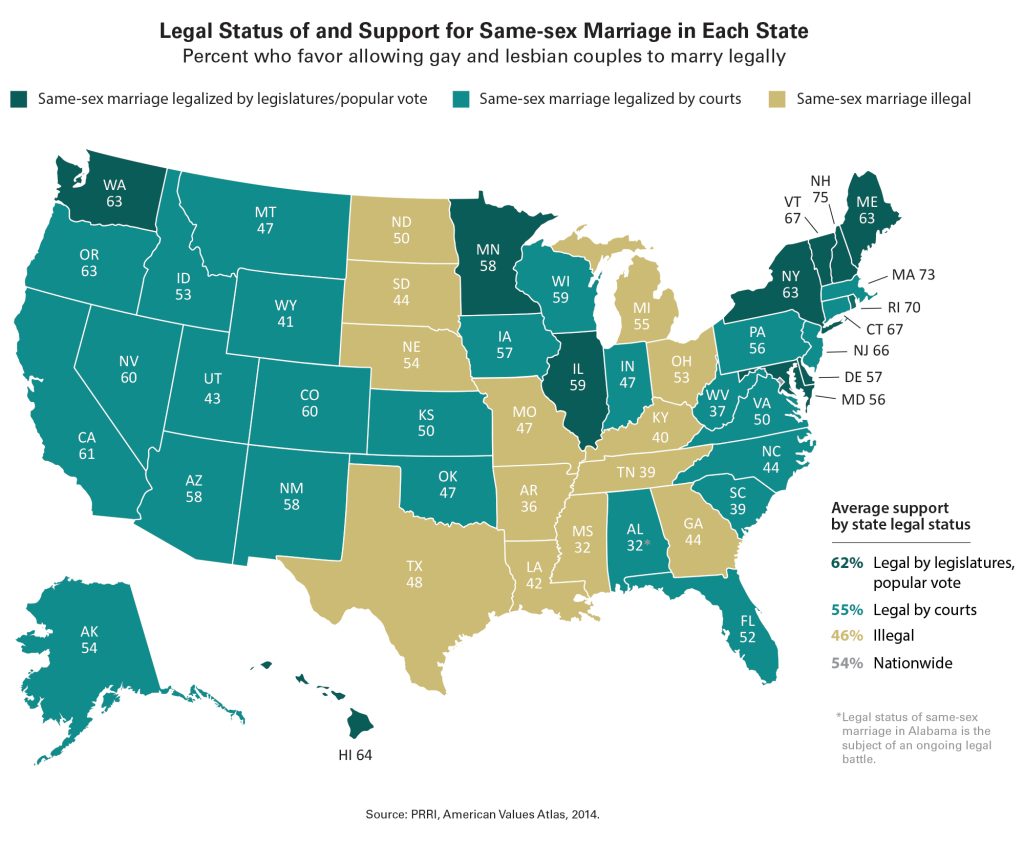
In the early 1970s, amid a burst of gay activism unleashed by the Stonewall riots in Greenwich Village, several same-sex couples filed lawsuits demanding marriage licenses. Courts did not take their arguments very seriously. A trial judge in Kentucky instructed one lesbian plaintiff that she would not be permitted into the courtroom unless she exchanged her pantsuit for a dress. Minnesota Supreme Court justices would not dignify the gay-marriage claim by asking even a single question at oral argument.
Check the full U.S. same-sex marriage timeline in another post.
Marriage equality was not then a priority of gay activists. Rather, they focused on decriminalizing consensual sex between same-sex partners, securing legislation forbidding discrimination based on sexual orientation in public accommodations and employment, and electing the nation’s first openly gay public officials.
Indeed, most gays and lesbians at the time were deeply ambivalent about marriage. Lesbian feminists tended to regard the institution as oppressive, given the traditional rules that defined it, such as coverture and immunity from rape.
Many sex radicals opposed traditional marriage’s insistent on monogamy. For them, gay liberation was sexual liberation. In the 1970s, gay-rights activism was more focused on visibility and personal liberation than on accessing institutions like marriage.
Some gay activists wanted to be allowed to marry in the 1970s. Others rejected the idea and considered marriage an obsolete institution. In December 1973, the American Psychiatric Association classified homosexuality as a mental disorder. The American Psychological Association followed suit in 1975.
There was a public backlash from opponents of gay rights because of the increased visibility of the LGBT community. Anita Bryant, a singer and former Miss Oklahoma, was a prominent opponent of gay rights. She founded Save Our Children and campaigned for the repeal of local ordinances prohibiting discrimination based upon sexual orientation.
The 1980s saw an increase in homophobia and discrimination due to the AIDS epidemic. This news also encouraged gay communities to organize. After the death of actor Rock Hudson, attitudes toward AIDS and the gay community began to shift.
In 1983, Congressman Gerry Studds, D-MA, became the first openly homosexual Congressman. He was followed by Congressman Barney Frank (D–MA) in 1987.
The federal Defense of Marriage Act was signed by President Bill Clinton on September 21, 1996. This federal law defined marriage as between a man or a woman at the federal level. Federal DOMA legislation ensured that no state could force gay marriages to be recognized in other states. It also prevented identical-sex couples from receiving federal protections and benefits as married heterosexual couples.
The Vermont Supreme Court unanimously ruled in Baker v. Vermont on December 20, 1999, that same-sex couples had the same rights, protections and benefits as heterosexual couples. Vermont was the first US state to establish civil unions on July 1, 2000. This gave same-sex married couples the same rights and protections as heterosexual couples, without calling it marriage.
The US Supreme Court ruled that sodomy laws are unconstitutional on June 26, 2003, in Lawrence v. Texas. The court overturned the June 30, 1986 court decision in Bowers vs Hardwick. Justice Antonin Scalia dissenting from that decision said that the majority decision “leaves upon pretty shaky ground state laws limiting marriages to opposite-sex partners.”
The Massachusetts Supreme Judicial Court ruled on November 18, 2003, that same-sex couples must be allowed to marry. The Massachusetts Supreme Judicial Court didn’t offer the legislature an alternative to marriage, as did the 1999 Vermont Supreme Court decision. The first legal gay marriage was conducted in the US on May 17, 2004, in Cambridge, MA by Tanya McCloskey (a massage therapist) and Marcia Kadish (an employment manager at an engineering company).
Four states had already banned gay marriages before 2004. Referenda were used to amend the constitutions of 13 states in 2004 to prohibit gay marriage. Between 2005 and Sep. 15, 2010, 14 additional states followed suit, bringing to 30 the total number of states that have constitutionally banned gay marriage.
The US Senate failed to approve a constitutional amendment banning gay marriage on July 14. It received 48 votes out of 60 votes. The US House of Representatives rejected a constitutional amendment to ban homosexual marriage on September 30, 2004, by 227 votes to 186. This was 49 votes short of the required two-thirds majority.
Governor Cuomo signed the Marriage Equality Act of New York into law on June 24, 2011. This allows same-sex couples to legally marry in New York.
Gay Marriage Legalized by US Supreme Court
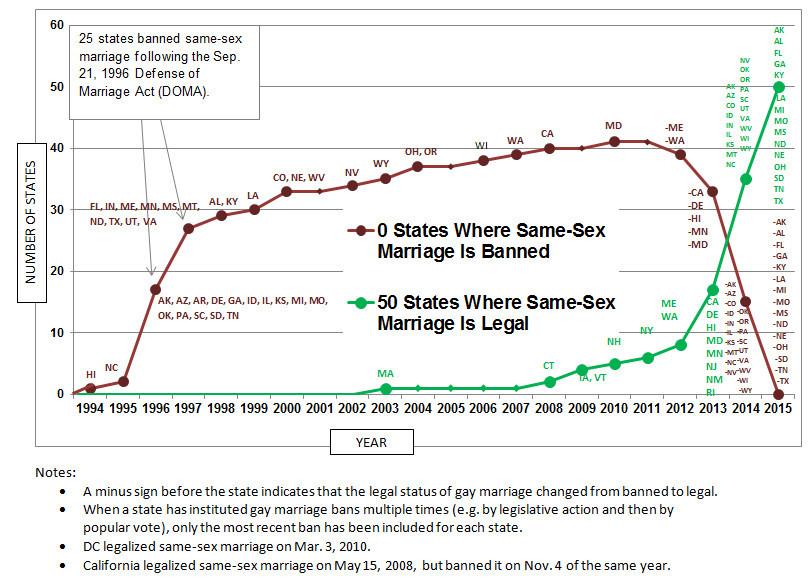
On April 28th, 2015, the US Supreme Court heard oral arguments in Obergefell v. Hodges. The argument revolved around whether gay marriage is a right guaranteed by the US Constitution and whether or not it can be legally recognized as a marriage in states that ban the practice.
The US Supreme Court ruled 5-4 on June 26, 2015, that the US Constitution gives equal-sex couples the right to marry in all 50 states.
Since the U.S. Supreme Court’s Obergefell v. Hodges ruling on June 26, 2015, Texas has legalized same-sex marriage. The U.S. state had previously banned same-sex marriage in Texas by both its statutes and its State Constitution. Associate Justice Anthony Kennedy stated that the Court in its majority opinion “held that same-sex couples can exercise their fundamental right to wed in all States.”
Alabama Chief Justice Roy Moore directed state probate judges not to issue marriage licenses for same-sex couples on Jan. 6, 2016. After a federal court had struck down Alabama’s ban against gay marriage, he issued a similar decision in February 2015. It is not clear if state probate judges follow these orders.
There was a backlash from states whose bans were overturned by Obergefell-v. Hodges’ ruling by the Supreme Court. Many county clerks quit or refused to issue marriage licenses for gay couples, or to grant marriage licenses for anyone, citing government infringement of their religious beliefs.
In the most public of cases, Kim Davis, Rowan County, Kentucky’s County Clerk, was briefly detained in September 2015 for contempt. She refused to issue marriage licenses for gay couples and ordered her staff to do so. Davis was released after her employees started issuing licenses in her absence. They said they would continue doing so when she returned to work.
SAME-SEX MARRIAGE AROUND THE WORLD
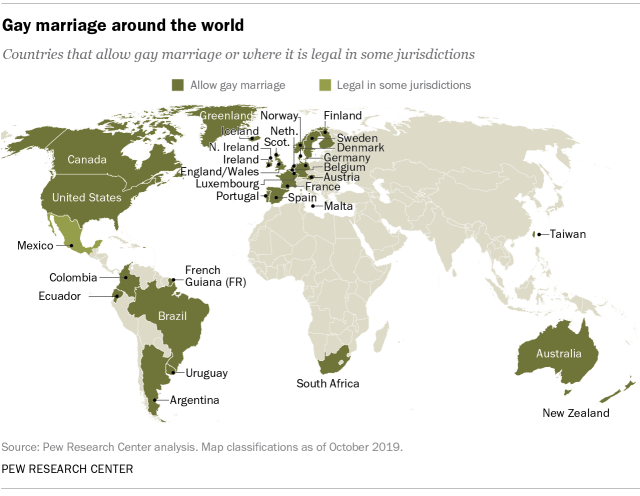
On April 1, 2001, four couples – one female and three male – were married in a televised ceremony officiated by the mayor of Amsterdam, in the Netherlands. This marked the world’s first legal gay marriage ceremony. In addition to the Netherlands, gay marriage is legal in over thirty countries.
Same-sex marriage has become legal in a growing number of countries in recent years. The United Kingdom’s Parliament in London recently legalized same-sex marriage in Northern Ireland, which had been the last UK constituent country to bar gay and lesbian couples from marrying. Same-sex marriages also became legal this year in Ecuador, Taiwan and Austria.
In some countries that have recently legalized same-sex marriage, the impetus for legal change came through the courts. For example, the May 17 vote in Taiwan’s Legislative Yuan (the official name of the nation’s unicameral parliament) was prompted by a 2017 decision by the country’s Constitutional Court, which struck down a law defining marriage as a union between a man and woman.
Likewise, Austria’s legalization of gay marriage at the beginning of 2019 came after a 2017 ruling by the country’s Constitutional Court. In the United States, the Supreme Court legalized gay marriage nationwide in a 2015 ruling.
Worldwide, most of the countries that allow gay marriage are in Western Europe. Still, many Western European nations, including Italy and Switzerland, do not allow same-sex unions. And, so far, no countries in Central and Eastern Europe have legalized gay marriage.
Along with New Zealand and Australia, Taiwan is one of only three nations in the Asia-Pacific region that has legalized same-sex unions. In Africa, only South Africa allows gays and lesbians to wed, which became legal in 2006.
In the Americas, five countries besides Ecuador and the U.S. – Argentina, Brazil, Canada, Colombia and Uruguay – have legalized gay marriage. In addition, some jurisdictions in Mexico allow same-sex couples to wed.
Japan does not recognize same-sex marriages or civil unions. It is the only country in the G7 that does not legally recognize same-sex unions in any form. Several municipalities and prefectures issue symbolic same-sex partnership certificates, which provide some benefits but do not offer any legal recognition.
Religion, churches, and same-sex marriage
Catholic Church
In October 2015, bishops attending the Fourteenth Ordinary General Assembly of the Synod of Bishops in Rome agreed on a final document which reiterated that while homosexuals should not be discriminated against unjustly, the Church was clear that same-sex marriage is “not even remotely analogous” to heterosexual marriage.
They also argued that local churches should not face pressure to recognize or support legislation that introduces same-sex marriage, nor should international bodies put conditions on financial aid to developing countries to force the introduction of laws that establish same-sex marriage.
Anglican Communion
As of 2016, “the more liberal provinces that are open to changing Church doctrine on marriage to allow same-sex unions include Brazil, Canada, New Zealand, Scotland, South India, South Africa, the US and Wales”.
In England and Wales, civil partnerships are permitted for clergy. “Neither the Church in Wales nor the Church of England are opposed to clergy being in civil partnerships. The Church of England requests that clergy in civil partnerships vow to remain sexually chaste, but the Church in Wales has no such restriction.”
The Church of England has allowed priests to enter into same-sex civil partnerships since 2005. The Church of Ireland recognizes the pensions for clergy in same-sex civil partnerships.
Homosexuality and Methodism
The African Methodist Episcopal Church does not explicitly support or prohibit the ordination of openly LGBTQ clergy. There is currently no prohibition against ordination, and the AME does not prohibit LGBTQ people from serving as pastors or leading the denomination.
The historic vote by the African Methodist Episcopal Church, which was the first vote in a predominantly African-American denomination on the issue regarding marriage rights for gay couples, saw the church unanimously reject ministers blessing such-sex unions in July 2004. According to church leaders, homosexual activity “clearly conflicts [their] understandings of Scripture.”
AME bans ministers from officiating at gay weddings. However, the AME has not “chosen” to make any official statements about homosexuality. Some openly gay clergy have been ordained by the AME.
Even though the AME voted against same-sex marriage, General Conference voted in favour of establishing a committee to examine and make recommendations for changes to the church’s teachings and pastoral care to LGBTQ members.
The Evangelical Methodist Church believes that homosexuality is condemned by the Bible as shown in Leviticus 18-22, Romans 1:26-27 and 1 Corinthians 6-9-19. It states that homosexual acts can lead to eternal punishment and spiritual death. However, homosexuality is not a greater sin than murder, adultery, and stealing.
Non-celibate homosexuals are therefore barred from joining the Evangelical Methodist Church. Furthermore, practicing homosexuals are not allowed to become candidates for the ordained ministry. While the Church believes that everyone has rights and protection under civil law, it strongly opposes any civil legislation that promotes homosexuality as a normal lifestyle.
All homosexuals who believe in Jesus Christ and stop practicing homosexual acts are welcome to the Evangelical Methodist Church.
What does the Bible say about homosexuality?
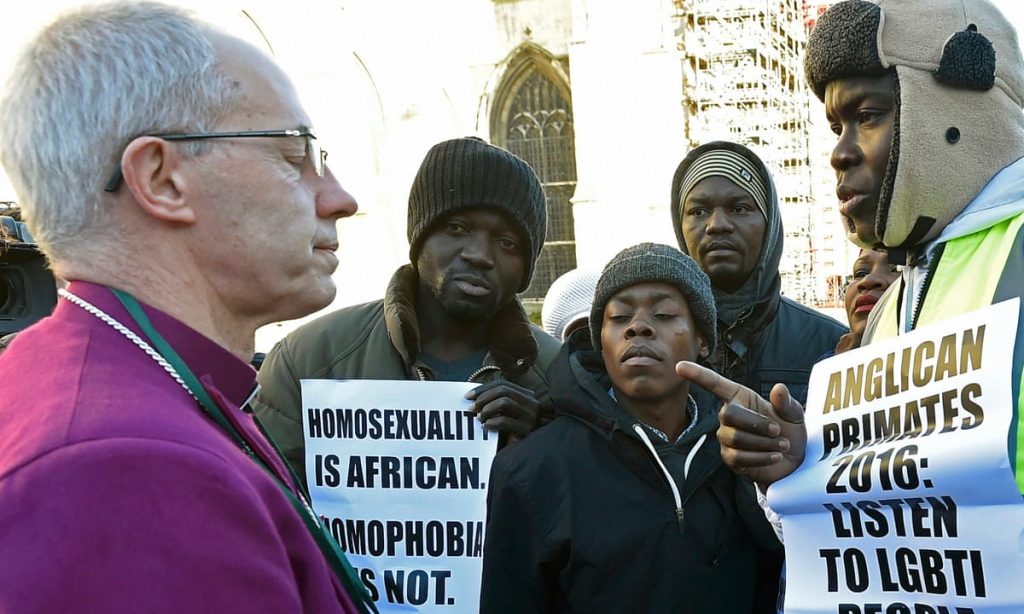
The Bible says nothing about ‘homosexuality’ as an innate dimension of personality. Sexual orientation was not understood in biblical times. But some people still find facts that in their opinion prove what Bible says about same-sex marriage.
The Bible defines marriage in Genesis 2:24 as a union between one man and one woman. Jesus Christ upholds this definition of marriage in Matthew 19:5, as does the Apostle Paul in Ephesians 5:31. Any sexual activity which takes place outside of this context is treated as sinful, what Jesus calls ‘sexual immorality’ in Mark 7:21.
Further to this, same-sex practice is specifically highlighted as sinful many times in Scripture. In God’s Law, for example, condemnations of same-sex practice are given in Leviticus 18:22 and 20:13.
Further references are made in the New Testament. For example, in Romans 1:24-32, amid echoes of the Genesis creation account, both male and female same-sex practices are treated as sinful. Further references to the sinfulness of same-sex practice can be seen in 1 Corinthians 6:9 and 1 Timothy 1:10.
The Scriptures are, therefore, consistent in their prohibition of same-sex sexual activity, across different periods of salvation history and within different cultural settings. Although the Scriptures are clear on sexual ethics, they also tell us that the prospect of forgiveness and eternal life is held out for anyone who turns from sin and puts their faith in Christ (Mark 1:15), no matter how they may have fallen short of his good design for sex and marriage.
Civil Unions
Civil union, civil partnership, domestic partnership, registered partnership, an unregistered partnership, and unregistered cohabitation statuses offer varying legal benefits of marriage.
Before the Obergefell decision, several states expanded the legal rights available to spouses in same-sex relationships through civil unions and domestic partnerships rather than permitting same-sex marriage. Since Obergefell requires that same-sex marriage be permitted in all states, it is unclear whether these alternatives will continue to be relevant or necessary.
However, they remain legally available and some couples continue to maintain a legal relationship through these forms. Civil unions provide legal recognition to the couples’ relationship and provide legal rights to the partners similar to those accorded to spouses in marriages.
SAME-SEX MARRIAGE IN POPULAR CULTURE
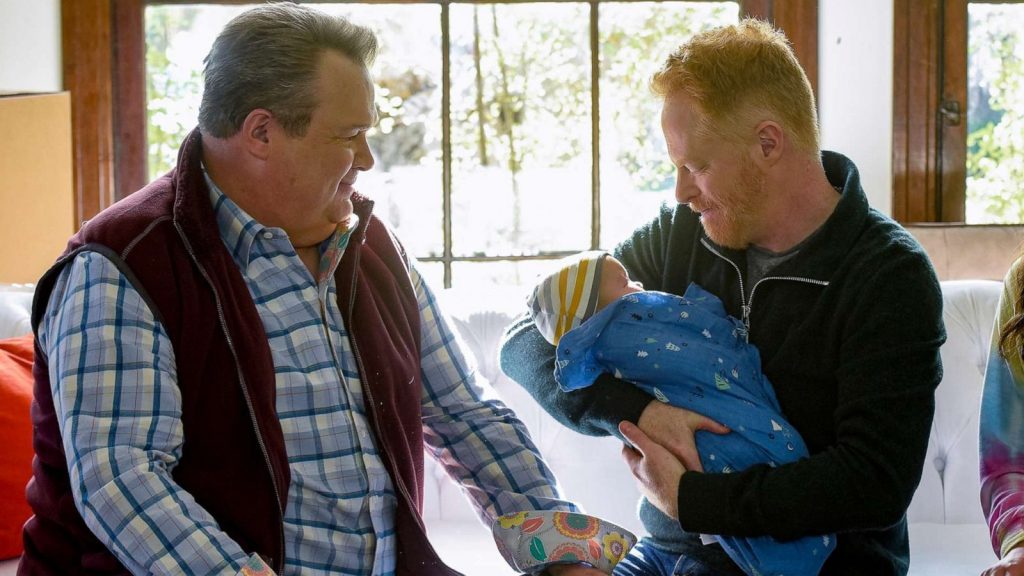
It’s impossible to know how much entertainment ever drives society rather than merely reflecting it. But it’s hard to avoid the feeling that the past five or six years have seen a virtuous cultural cycle.
2009 was the year that audiences met Cam and Mitch (Eric Stonestreet and Jesse Tyler Ferguson), a gay couple living together with an adopted daughter. They weren’t married when the series began—Proposition 8 in their native California forbade them to, and they tied the knot once it was overturned—but they were navigating the challenges of being in a long-term relationship on screen every week as around 10 million people watched at home.
The show became one of the few cross-culturally appealing TV works of the Obama years, viewed in red states and blue states, name-checked by Ann Romney and the president alike. A 2012 Hollywood Reporter poll found that 27 percent of likely voters said that depictions of gay characters on TV made them more pro-gay marriage, and there are news accounts of people crediting their newfound sympathy toward gay people to Modern Family.
Television has featured queer people for decades (Will & Grace, Glee, All in the Family and Golden Girls). It has been slow progress, however. Most of these programs perpetuated stereotypes and focused on white people to the exclusion of all other people.
Cam and Mitch have been about as tame as anyone could ask—in contrast to the straight couples they hang out with, they rarely touch, never talk about sex, and make a big deal over kissing in public.
But the fact remains that each popular depiction of gay life helped encourage networks to take chances on others, and today there’s unprecedented diversity in the representation of sexuality on television, as shown in programs like Empire and Orange Is the New Black.
Facts about same-sex marriage
The share of Americans who favor same sex-marriage grew steadily for most of the last decade, but public support has leveled off in the last few years. Around four-in-ten U.S. adults (37%) favored allowing gays and lesbians to wed in 2009, a share that rose to 62% in 2017. But views are largely unchanged over the last few years. About six-in-ten Americans (61%) support same-sex marriage in the most recent Pew Research Center survey on the issue, conducted in March 2019.
Although support in the U.S. for same-sex marriage has increased among nearly all demographic groups, there are still sizable demographic and partisan divides. For example, today, 79% of Americans who are religiously unaffiliated favor same-sex marriage, as do 66% of white mainline Protestants and 61% of Catholics. Among white evangelical Protestants, however, only 29% favor same-sex marriage. Still, this is roughly double the level (15%) in 2009.
While support for same-sex marriage has grown steadily across generational cohorts in the last 15 years, there are still sizable age gaps. For instance, 45% of adults in the Silent Generation (those born between 1928 and 1945) favor allowing gays and lesbians to wed, compared with 74% of Millennials (born between 1981 and 1996). There also is a sizable political divide: Republicans and Republican-leaning independents are much less likely to favor same sex marriage than Democrats and Democratic leaners (44% vs. 75%).
Same-sex marriages are on the rise. Surveys conducted by Gallup in 2017 find that about one-in-ten LGBT Americans (10.2%) are married to a same-sex partner, up from the months before the high court decision (7.9%). As a result, a majority (61%) of same-sex cohabiting couples were married as of 2017, up from 38% before the ruling.
As with the general public, Americans who identify as lesbian, gay, bisexual or transgender (LGBT) are most likely to cite love as a very important reason for getting married. In a 2013 Pew Research Center survey, 84% of LGBT adults and 88% of the general public cited love as a very important reason for getting married, and at least seven-in-ten in both groups cited companionship (71% and 76%, respectively). But there were some differences, too. LGBT Americans, for instance, were twice as likely as those in the general public to cite legal rights and benefits as a very important reason for getting married (46% versus 23%), while those in the general public were nearly twice as likely as LGBT Americans to cite having children (49% versus 28%).
The U.S. is among 29 countries and jurisdictions that allow gay and lesbian couples to wed. The first nation to legalize gay marriage was the Netherlands, which did so in 2000. Since then, several other European countries – including England and Wales, France, Ireland, all of Scandinavia, Spain and, most recently, Austria, Germany and Malta – have legalized gay marriage. Outside of Europe, same-sex marriage is now legal in Argentina, Australia, Brazil, Canada, Colombia, Ecuador, New Zealand, South Africa and Uruguay, as well as in parts of Mexico. And in May 2019, Taiwan became the first country in Asia to allow gays and lesbians to legally wed.
Wait, there’s more. Here are 11 more facts about LGBTQ marriage from the U.S. and around the world.
1. The Netherlands became the first country to legalize same-sex marriage in 2001.
2. As of 2014, 13 more countries have legalized same-sex marriage. South Africa, Belgium, Denmark, Sweden, Canada, and Spain are a few of these countries. Massachusetts was the first US state to legalize same-sex marriage in 2004.
3. As of 2014, 20 states have followed: Iowa, Vermont, Maine, New York, Connecticut, Washington, Maryland, New Hampshire, Oregon, California, New Mexico, Minnesota, Iowa, Illinois, Indiana, Hawaii, Rhode Island, Delaware, Pennsylvania, and Washington D.C.
4. In 2012, President Obama made US History when he told ABC News, “I think same-sex couples should be able to get married. Ask your friends and other social influencers to show their support for LGBTQ rights. Sign up for Love It Forward.
5. Alaska and Hawaii were the first states to legally ban same-sex marriage in 1998.
6. 16 states ban same-sex marriage, some by constitutional amendment, some by law, and the majority by both.
7. 7 states provide some, if not all, spousal rights to unmarried couples in domestic partnerships, including California, Nevada, Oregon, Washington, Hawaii, Maine, and Wisconsin.
8. As of 2014, 55% of Americans believe same-sex marriage should be legal.
9. In 2013, the Supreme Court struck down parts of the Defense of Marriage Act (DOMA) (which defined marriage as a union between man and woman) and declared that the federal government would recognize same-sex marriages as legal.
10. In many countries such as Sudan, Iran, and Saudi Arabia, gay people can be punished with the death penalty.
11. Though same-sex marriage wasn’t legal until the 2000s, same-sex couples were getting married on TV shows in the 1990s. The sitcom “Roseanne” featured a same-sex marriage in 1995 while “Friends” featured a lesbian wedding in 1996.
Frequently asked questions
References & Further Reading
- History of Gay Marriage at ProCon.org
- Books on Gay & Lesbian Marriage at Barnes & Nobel
- Pop culture shaping same-sex marriage debate at LA Times
- Same-sex Marriage Around the World at Pew Research Center
- Religious views on same-sex marriage at Wikipedia.org